THE WORLD BIRDS - An Online Bird Book
RAPTORS - Old World Vultures
Old World Vultures
Order Accipitriformes Family Accipitridae
RAPTORS - Old World Vultures
Raptors are birds of prey. They are carnivorous, long lived, and have low reproductive rates. They catch their prey via strong claws – three pointing forward and one pointing backward. The raptors that hunt by day are: hawks, eagle, kites, vultures, falcons. Owls hunt by night. The raptors are spread over a number of orders: Accipitriformes (hawks and allies), Cathartiformes (New World vultures), Falconiformes (falcons), Strigiformes (owls).
Unlike most other birds, or mammals for that matter, almost all female raptors are larger than their male counterpart. There is no consensus as why evolution worked this way for the raptor. The theory I like best is that the bigger female can defend the nest better, while the smaller male is more agile and can find lots of little prey to bring home to the nest. That is, when the chicks are young, they need lots of little tidbits, not one humungous carcass. A side benefit of having male and female being different in size is that they tend to go after different food sources so that way they are not competing with each other for food. But if males were the bigger ones, that diversity benefit would also be true. So perhaps the overarching reason, is the male bringing home lots of tidbits.
Raptors, especially those that stalk prey from the air, tend to have dark upperparts and lighter underparts. Looking down from above a raptor, the dark upperparts tend to blend in with the ground. While looking from below, the light underparts blend better with the sky.
Many of the raptors have their conservation status listed as something other than Least Concern; that is, there is some concern about their survival. A contributing factor is that raptors need a considerable area to offer them sufficient prey. As habitats degrade, they have less area to patrol, and less prey in the remaining areas, a double whammy. Also, for millennia, raptors have been at the top of the food chain and did not need to worry about their longterm survival. As a result, they have evolved to have few offspring, sometimes only 1. Thus if a population decreases, it is hard for it to recover.
Accipitriformes
The order Accipitriformes is made of of three families: Accipitridae, Pandionidae, and Sagittariidae. Accipitridae contains the hawks, eagles, kites, Old World vultures. Pandionidae only contains one species - the osprey, and Sagittariidae only contains the secretary bird.
Accipitridae
The Accipitridae family has the following subfamiles:
Aquilinae – booted eagles
Circaetinae – serpent eagles
Harpiinae – forest eagles
Accipitrinae – accipitrine hawks
Buteoninae – buteonine hawks
Harpaginae – harpagine hawks
Melieraxinae – melieraxine hawks
Elaninae – elanine kites
Perninae – honey-buzzards
Gypaetinae – gypaetine vultures and harrier-hawks
Gypinae – Old World vultures
Unlike most other birds, or mammals for that matter, almost all female raptors are larger than their male counterpart. There is no consensus as why evolution worked this way for the raptor. The theory I like best is that the bigger female can defend the nest better, while the smaller male is more agile and can find lots of little prey to bring home to the nest. That is, when the chicks are young, they need lots of little tidbits, not one humungous carcass. A side benefit of having male and female being different in size is that they tend to go after different food sources so that way they are not competing with each other for food. But if males were the bigger ones, that diversity benefit would also be true. So perhaps the overarching reason, is the male bringing home lots of tidbits.
Raptors, especially those that stalk prey from the air, tend to have dark upperparts and lighter underparts. Looking down from above a raptor, the dark upperparts tend to blend in with the ground. While looking from below, the light underparts blend better with the sky.
Many of the raptors have their conservation status listed as something other than Least Concern; that is, there is some concern about their survival. A contributing factor is that raptors need a considerable area to offer them sufficient prey. As habitats degrade, they have less area to patrol, and less prey in the remaining areas, a double whammy. Also, for millennia, raptors have been at the top of the food chain and did not need to worry about their longterm survival. As a result, they have evolved to have few offspring, sometimes only 1. Thus if a population decreases, it is hard for it to recover.
Accipitriformes
The order Accipitriformes is made of of three families: Accipitridae, Pandionidae, and Sagittariidae. Accipitridae contains the hawks, eagles, kites, Old World vultures. Pandionidae only contains one species - the osprey, and Sagittariidae only contains the secretary bird.
Accipitridae
The Accipitridae family has the following subfamiles:
Aquilinae – booted eagles
Circaetinae – serpent eagles
Harpiinae – forest eagles
Accipitrinae – accipitrine hawks
Buteoninae – buteonine hawks
Harpaginae – harpagine hawks
Melieraxinae – melieraxine hawks
Elaninae – elanine kites
Perninae – honey-buzzards
Gypaetinae – gypaetine vultures and harrier-hawks
Gypinae – Old World vultures
Old World Vultures
Order Accipitriformes Family Accipitridae
Old World vultures are not closely related to New World vultures. They resemble each other because of convergent evolution. Vultures in general feed on dead animals. They tend to have bald heads to minimize the feathers that get contaminated from carrion. They have broad wings for efficient soaring, Old World vulture do not have a good sense of smell and thus locate their meals by sight.
Many of the vulture species have a declining population. Often the major reason for the decline is eating carrion that contains the drug diclofenac which is a steroid vets give to working animals to reduce joint pain. This drug can cause kidney failure in some vulture species. Other contributing factors to their decline are: collisions with power lines, eating lead gunshot, hunting for use in "medicine and magic", and a decline in available carcasses. In general, vultures take years to sexually mature and when they do produce young they are not prolific. The decline of vultures populations can result in carcasses not being eaten which in turn contributes to the spread of disease.
There are two Accipitridae subfamilies for the Old World vultures: Gypaetinae and Gypinae.
Gypaetinae – gypaetine vultures and harrier-hawks
There are only 5 species in the Gypaetinae subfamily and only the bearded vulture specializes in eating carrion. The palm-nut vulture mainly eats the fruit of palm trees; the Egyptian vulture eats mammal feces, insects in dung, live mammals, carrion; and the two harrier-hawk species do not eat carrion. Because of these eating habits, some taxonomic authorities place the Gypaetinae within the Perninae hawks. All of these species are found in Africa. The bearded vulture and Egyptian vulture are also found in Europe and Asia.
Genus Gypaetus - 1 species
Vulture,_Bearded Gypaetus barbatus
Description: The bearded vulture, also known as the lammergeier, has blackish-grey upperparts and off-white to rusty underparts. It has a whitish head and neck. The bearded vulture has a black mask that extends to form a short beard. It has a feathered neck and legs plus a wedge-shaped tail. It is 95 to 125 cm long and weighs between 4500 and 7000 grams.
Range: Europe, Asia, Africa.
Habitat: Mainly mountains areas, but does visit nearby plains. Prefers open areas with little vegetation or snow.
Diet: Mainly dead mammals. Also dead birds and reptiles.
Conservation status: The bearded vulture is listed as Near Threatened because of encroaching humanity. They had largely disappeared from Europe, but are being reintroduced.
Image by: 1, 2) Richard Bartz 3) Rob 4) Jayhem - SwitzerlandRange: Europe, Asia, Africa.
Habitat: Mainly mountains areas, but does visit nearby plains. Prefers open areas with little vegetation or snow.
Diet: Mainly dead mammals. Also dead birds and reptiles.
Conservation status: The bearded vulture is listed as Near Threatened because of encroaching humanity. They had largely disappeared from Europe, but are being reintroduced.

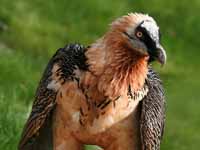
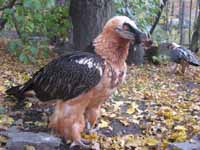

Genus Gypohierax - 1 species
Vulture,_Palm-nut Gypohierax angolensis
Description: The palm-nut vulture has a white head, body, and wing coverts. The flight feathers and square tail are black. They are 60 cm long and weigh from 1300 to 1700 grams.
Range: Sub-Saharan Africa.
Habitat: Forests and savannas, usually near water. They are tolerant of humans.
Diet: 60% of adult food comes from palm fruits. Also fish, crabs, small mammals, birds, insects. Only infrequently do they eat carrion.
Conservation status: Least Concern.
Image by: 1) Dick Daniels - Jacksonville Zoo 2) Nik Borrow - Libia 3)
Sergey Yeliseev - Kenya 4) Sias van Schalkwyk - South Africa Range: Sub-Saharan Africa.
Habitat: Forests and savannas, usually near water. They are tolerant of humans.
Diet: 60% of adult food comes from palm fruits. Also fish, crabs, small mammals, birds, insects. Only infrequently do they eat carrion.
Conservation status: Least Concern.

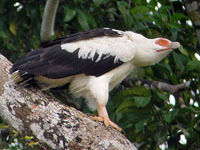


Genus Neophron - 1 species
Vulture,_Egyptian Neophron percnopterus
Description: The Egyptian vulture has white plumage with black flight feathers. It has a long, slender bill and pink legs (grey for juvenile). There is yellow facial skin which borders a black tipped bill. They are mostly silent but make high pitched hissing at their nest and screeching noises when disputing a carcass. It is 54 to 70 cm long and the weight between 1600 and 2400 grams.
Range: Europe, Asia, Africa.
Habitat: Mainly dry plains and low hills. Nest mainly on rock cliffs.
Diet: Mammal feces, insects in dung, live mammals, carrion. At carrion they usually weight until bigger vultures have their fill. They spend much time soaring, probably searching for food.
Conservation status: The Egyptian vulture is listed as Endangered because of a declining population. Poison seems to be the main problem, but also power line collisions and eating of lead gunshot.
Image by: 1) Sandy Cole - San Diego Zoo 2) Dick
Daniels - San Diego Zoo 3) Norbert Potensky 4) Sergey Yeliseev - IsraelRange: Europe, Asia, Africa.
Habitat: Mainly dry plains and low hills. Nest mainly on rock cliffs.
Diet: Mammal feces, insects in dung, live mammals, carrion. At carrion they usually weight until bigger vultures have their fill. They spend much time soaring, probably searching for food.
Conservation status: The Egyptian vulture is listed as Endangered because of a declining population. Poison seems to be the main problem, but also power line collisions and eating of lead gunshot.

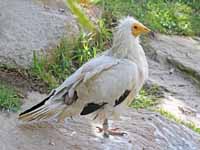
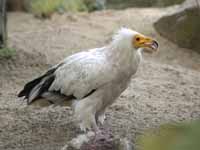

Genus Polyboroides
Hawk,_African Harrier-Polyboroides typus
Description: The African harrier-hawk, also known as the harrier hawk or gymnogene, has mainly grey plumage with thin dark banding on the lower breast and belly. It has a black tail with single white band and black flight feathers. There is a yellow eye-patch. It is 51 to 68 cm long with the male weighing up to 700 grams and the female 825 g.
Range: Africa, most common in the western tropical regions.
Habitat: Varied from the rainforest, to forest edges, cropland, and civilized areas.
Diet: Fruit of the palm, mammals, birds. It hunts by soaring, perching, and ground foraging.
Conservation status: Least Concern.
Image by: 1) Charlie Westerinen - Botswana 2) Dick Daniels - World of Birds, South Africa 3) Charles_Sharp - Zimbabwe 4) Andrew_Keys - South AfricaRange: Africa, most common in the western tropical regions.
Habitat: Varied from the rainforest, to forest edges, cropland, and civilized areas.
Diet: Fruit of the palm, mammals, birds. It hunts by soaring, perching, and ground foraging.
Conservation status: Least Concern.




Hawk,_Madagascar Harrier- Polyboroides radiatus
Description: The Madagascar harrier-hawk has mainly grey upperparts and light grey underparts with heavy barring on the lower-breast and belly. The tail is black with single white band. It has black flight feathers and a yellow eye-patch. It is 57 to 68 cm long,
Range: Madagascar.
Habitat: Throughout most of Madagascar, but it is scarce on the deforested central plateau.
Diet: Birds, rodents, reptiles, insects.
Conservation status: Least Concern.
Image by: 1) Werner Witte 2) Frank Wouters Charles_SharpRange: Madagascar.
Habitat: Throughout most of Madagascar, but it is scarce on the deforested central plateau.
Diet: Birds, rodents, reptiles, insects.
Conservation status: Least Concern.
1) Juvenile
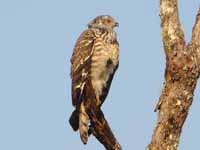
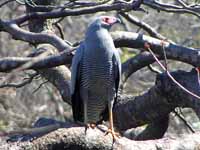

Gypinae – Old World vultures
In general vultures are not pleasant to look at, at least from a human perspective. Their body has evolved to efficiently tear into dead bodies, even those that are rotting. A gruesome task, but a necessary one and very benificial to nature and humans specifically. Following the tenant "beauty is as beauty does" could they really be beautiful?
There are 13 species in the Gypinae subfamily. Eight of these belong the Gyps genus and are often referred to as griffon vultures. They have an unfeathered head and neck,which are usually covered with light colored fuzz. They have a light colored fluffy neck collar termed a ruff. The population of most Gyps vultures are declining.
Genus Aegypius - 1 species
Vulture,_Monk Aegypius monachus
Description: The monk vulture, also known as the cinereous vulture, has mainly brown plumage with blackish-brown flight feathers and tail. It has a large bill plus a pale crown and nape. It is one of the largest Old World vultures. It is 98 to 120 cm long and weighs between 6.3 and 11.5 kg. The juvenile is darker and the head is covered with black down.
Range: Europe, Asia, Africa.
Habitat: Forest areas in hilly terrain; also steppes and grasslands.
Diet: Mainly carrion.
Conservation status: The monk vulture is considered to be Near Threatened because of poisons and carrion becoming less available.
Image by: 1, 3) Koshy_Koshy - India 2) Joachim S. Müller 4) Artemy_Voikhansky - IsraelRange: Europe, Asia, Africa.
Habitat: Forest areas in hilly terrain; also steppes and grasslands.
Diet: Mainly carrion.
Conservation status: The monk vulture is considered to be Near Threatened because of poisons and carrion becoming less available.
1) Juvenile

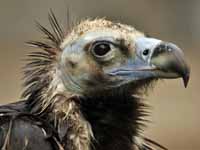

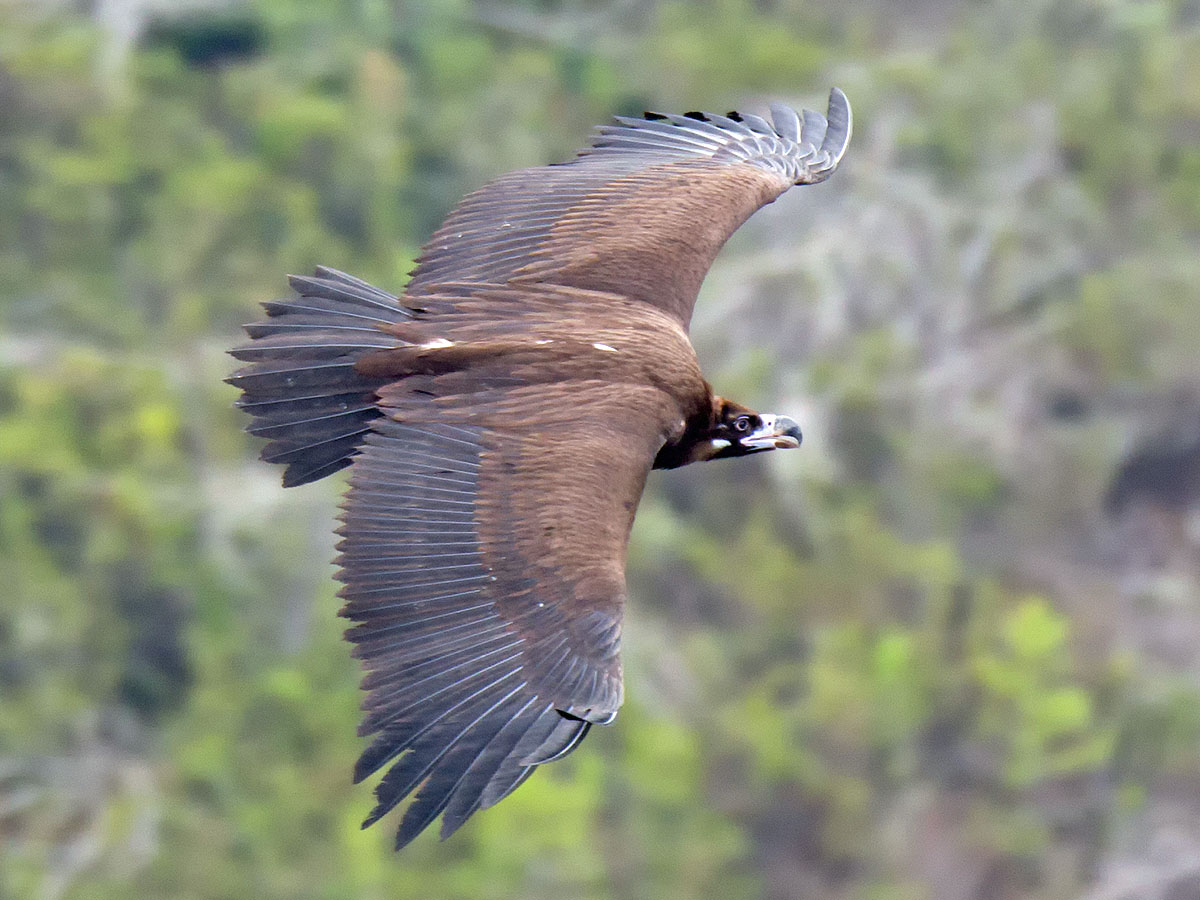
Genus Gyps
The Griffon vultures all mainly eat carrion. For sanitary reasons they have evolved to have an unfeathered head and neck, usually covered with light colored fuzz. They have a light colored fluffy neck collar termed a ruff. The population of most Gyps vultures are declining. A major reason for this decline is eating carrion that contains the drug diclofenac which is a steroid vets give to working animals to reduce joint pain. This drug can cause kidney failure in some vulture species. The decline of vultures results in carcasses not being eaten which in turn contributes to the spread of disease.
The Eurasian griffon vulture is found in Europe, Asia, and Africa. The remaining species in this genus are found in Africa and / or Asia.
Vulture,_Cape Gyps coprotheres
Description: The Cape vulture, also known as the Ca[e griffon vulture, has mainly whitish plumage with black flight feathers and tail. The head and neck are covered with fuzz, the eyes are yellowish, and the bill is black. It is 96 10 115 cm long, and weighs between 7 and 11 kg. The similar white-backed vulture has a duller white than the Cape vulture.
Range: Africa.
Habitat: Breeds and roosts on cliff faces in or near mountains. It will travel long distances while soaring in search of large carcasses.
Diet: Carrion.
Conservation status: The Cape vulture is listed as Endangered because of a steady decline of its population due to a reduction of available carcasses and also to poisoning.
Image by: 1) Ian White 2) Heather Paul 3) Cristiano Crolle - Namibia 4) NJR ZARange: Africa.
Habitat: Breeds and roosts on cliff faces in or near mountains. It will travel long distances while soaring in search of large carcasses.
Diet: Carrion.
Conservation status: The Cape vulture is listed as Endangered because of a steady decline of its population due to a reduction of available carcasses and also to poisoning.

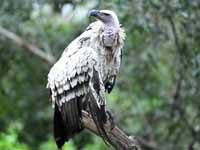


Vulture,_Eurasian Griffon Gyps fulvus
Description: The Eurasian griffon vulture, also known as the griffon vulture, has a buff back, wing coverts, and underparts. It has black flight feathers and tail. The head and neck are white. It grunts or hisses while roosting and also when feeding on carrion. It never kills its prey and will wait patiently if it shows any life. The griffon vulture lays just one egg and the parents alternate days incubation days. It is 93 to 110 cm long and weighs between 6 and 10 kg.
Range: Europe, Asia, Africa.
Habitat: Breeds at rocky hills or mountains. Looks for prey at open areas.
Diet: Carrion which is found by soaring, often while in flocks.
Conservation status: Least Concern.




Vulture,_Himalayan Gyps himalayensis
Description: The Himalayan griffon vulture, also know as the Himalayan griffon, has mainly buff upperparts with dark brown wing coverts and tail. The underparts are buff. Seen from below, the wing coverts are whitish and the flight feathers are dark brown. The bill is large, heavy, pale yellow, and with a pale brown cere. There is yellowish down on the head and neck (white for juvenile). It is 103 to 110 cm long and weights 8 to 12 kg.
Range: Asia.
Habitat: High regions of the Himalayas. They soar on thermals.
Diet: Carrion.
Conservation status: The Himalayan griffon is considered to be Near Threatened because of threats from poison. However, its population seems to be stable.
Image by: 1) Koshy_Koshy - India 2) Sahana_M - northern India 3) Imram_Shah - PakistanRange: Asia.
Habitat: High regions of the Himalayas. They soar on thermals.
Diet: Carrion.
Conservation status: The Himalayan griffon is considered to be Near Threatened because of threats from poison. However, its population seems to be stable.
1) Juvenile



Vulture,_Indian Gyps indicus
Description: The Indian vulture, once known as the long-billed vulture, is on the verge of extinction due to poisoning of dying cattle. It has mainly pale plumage. The flight feathers, tail, head, and neck are darker. It has a pale yellow bill and dark brown eyes. The head and neck are darker than other Gyps vultures that are in its range.
Range: India.
Habitat: Plains and open country near villages. It breeds on cliffs.
Diet: Carrion.
Conservation status: The Indian vulture is Critically Endangered due to being poisoned by diclofenac. That steroid is being replaced by meloxicam which is harmless to vultures. It is hoped that a captive breeding program will eventually reverse the population decline.
Image by:
1) Shantanu_Kuveskar 2) Shankar_Raman 3) Sandeep Somasekharan - Ramanagaram, IndiaRange: India.
Habitat: Plains and open country near villages. It breeds on cliffs.
Diet: Carrion.
Conservation status: The Indian vulture is Critically Endangered due to being poisoned by diclofenac. That steroid is being replaced by meloxicam which is harmless to vultures. It is hoped that a captive breeding program will eventually reverse the population decline.



Vulture,_Rüppell's also Rüppell's Griffon Vulture Gyps rueppelli
Description: The Rüppell's vulture has mottled dark brown upperparts and pale brown underparts. It has a bald head and fluffy white collar. The bill is orange and the eyes are yellow. It is 85 to 103 cm long and weighs 6.4 to 9 kg. It can soar at very high heights; one was confirmed to be ingested by a jet engine at 11,000 meters.
Range: Central Africa.
Habitat: Open areas such as steppes and grassland. Roost and nest in cliffs and gorges.
Diet: Carrion.
Conservation status: It is listed as Critically Endangered because of declining population due mainly to eating poisoned meat, but also used for "medicine and magic".
Image by: 1) Carol Foil - Kenya 2) Dick Daniels - Tanzania 3, 4) Nik_Borrow - TanzaniaRange: Central Africa.
Habitat: Open areas such as steppes and grassland. Roost and nest in cliffs and gorges.
Diet: Carrion.
Conservation status: It is listed as Critically Endangered because of declining population due mainly to eating poisoned meat, but also used for "medicine and magic".


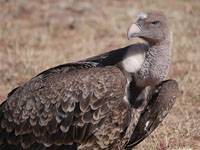

Vulture,_Slender-billed Gyps tenuirostris
Description: The slender-billed vulture has mainly grey plumage. It has a pale rump, grey under-tail coverts, whitish down on thighs, and a narrow dark bill plus cere. It is 75 to 100 cm long. This vulture used to be conspecific with the Indian vulture. They have different ranges: the Indian vulture found south of Ganges. and the slender-billed vulture found in sub-Himalayan regions and into southeast Asia.
Range: Himilayan foothills and Southeast Asia.
Habitat: Open country and partially wooded areas. It nests in trees.
Diet: Carrion.
Conservation status: The slender-billed vulture is Critically Endangered because of eating carcasses treated with the drug diclofenac.
Image by: 1) Mike_Prince 2) Bill_Bacon - CambodiaRange: Himilayan foothills and Southeast Asia.
Habitat: Open country and partially wooded areas. It nests in trees.
Diet: Carrion.
Conservation status: The slender-billed vulture is Critically Endangered because of eating carcasses treated with the drug diclofenac.


Vulture,_White-backed Gyps africanus
Description: The white-backed vulture , also known as the African white-backed vulture, has a whitish back, wing coverts, neck, and underparts. The flight feathers and tail are black. The juvenile is mostly black with a white neck. The similar cape vulture has a whiter white than the white-backed vulture.
Range: Sub-Saharan Africa.
Habitat: Open plains and savanna.
Diet: Carrion. The carcass must have soft tissue as the vulture bill can not tear through tough skin.
Conservation status: Like too many members of its genus, the white-backed vulture is Critically Endangered. Its population is declining because of diclofenac, other chemicals, and also a reduced number of trees for nests.
Image by: 1) Lip Kee - Kenya 2, 4,Dick Daniels - Keekorok Lodge in the Masai Mara, Kenya 3) Dick - Jacksonville Zoo, Florida 5) Charlie Westerinen - Zimbabwe Range: Sub-Saharan Africa.
Habitat: Open plains and savanna.
Diet: Carrion. The carcass must have soft tissue as the vulture bill can not tear through tough skin.
Conservation status: Like too many members of its genus, the white-backed vulture is Critically Endangered. Its population is declining because of diclofenac, other chemicals, and also a reduced number of trees for nests.
1) Juvenile




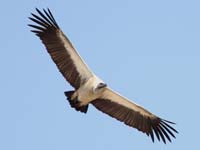
Vulture,_White-rumped Gyps bengalensis
Description: The white-rumped vulture has mainly dark plumage. It has a white ruff and white under-wing coverts. It does have a white rump, but it is hard to see. The white-rumped vulture is the smallest of the Gyps genus, but still good sized with a length from 75 to 93 cm and a weight from 3.5 to 7,5 kg.
Range: Lowlands of Iran to India, sw China and SE Asia.
Habitat: Open low open country often close to human activity such as rubbish dumps and slaughterhouses.
Diet: Carrion, especially remains of cattle.
Conservation status: The white-rumped vulture is Critically Endangered because of poisoning by diclofenac.
Image by: 1) Goran Ekstrom 2) Steve Babb 3) Umang Dutt - IndiaRange: Lowlands of Iran to India, sw China and SE Asia.
Habitat: Open low open country often close to human activity such as rubbish dumps and slaughterhouses.
Diet: Carrion, especially remains of cattle.
Conservation status: The white-rumped vulture is Critically Endangered because of poisoning by diclofenac.



Genus Necrosyrtes - 1 species
Vulture,_Hooded Necrosyrtes monachus
Description: The hooded vulture has mainly dark brown plumage. It has a pink head, greyish "hood", long thin bill, downy nape, and white throat. It is a small vulture: 62 to 72 cm long and 1200 to 1500 grams. The similar lappet-faced vulture is considerably larger than the Hooded vulture and has a more massive bill.
Range: Sub-Saharan Africa.
Habitat: Open woodland, forest edges, and savanna.
Diet: mainly carrion, including dead fish; also insects.
Conservation status: The hodded vulture is Critically Endangered because of poisoning and hunting.
Image by: 1) Dick Daniels - San Diego Zoo 2) Gabriel Buissart 3) Darren
Bellerby - Maasai Mara, Kenya 4) Dick - Keekorok Lodge in the Masai Mara, KenyaRange: Sub-Saharan Africa.
Habitat: Open woodland, forest edges, and savanna.
Diet: mainly carrion, including dead fish; also insects.
Conservation status: The hodded vulture is Critically Endangered because of poisoning and hunting.



Genus Sarcogyps - 1 species
Vulture,_Red-headed Sarcogyps calvus
Description: The red-headed vulture has a red to orange head, black body, and white bib. The lower half of the bill is dark, often black. The male has yellow eyes and the female has brown. They are 76 to 86 cm long and weigh between 3600 and 5400 grams.
Range: mainly Indian Subcontinent; also southeast Asia.
Habitat: Deciduous forests, open country.
Diet: Carrion.
Conservation status: The red-headed vulture is listed as Critically Endangered because of a rapid population decline from ingestion of the anti-inflammatory drug diclofenac.
Image by: 1) Davidvraju - India 2) Sumeet_Moghe - India 3) Diyendu AshRange: mainly Indian Subcontinent; also southeast Asia.
Habitat: Deciduous forests, open country.
Diet: Carrion.
Conservation status: The red-headed vulture is listed as Critically Endangered because of a rapid population decline from ingestion of the anti-inflammatory drug diclofenac.
1) Female 2, 3) Male



Genus Torgos - 1 species
Vulture,_Lappet-faced Torgos tracheliotos
Description: The lappet-faced vulture has blackish upperparts and white to buff underparts. It has white leggings. The definition of the word lappet refers to folds on a garment. The term was applied to this vulture because of folds on its facial skin. It is a large vulture: 95 to 115 cm in length and 5400 to 9400 grams. The lappet-faced vulture is considerably larger than the similar hooded vulture and has a more massive bill.
Range: Africa and the Arabian Peninsula.
Habitat: Dry savannah, thornbush, arid plains.
Diet: Carrion.
Conservation status: The lappet-faced vulture is listed as Endangered as its population is declining because of poison, hunting, and the reduction of available carcasses.
Image by: 1)) Dick - Tanzania 2) Darren
Bellerby - Maasai Mara, Kenya 3) Nik_Borrow - Tanzania 4) Johann du PreezRange: Africa and the Arabian Peninsula.
Habitat: Dry savannah, thornbush, arid plains.
Diet: Carrion.
Conservation status: The lappet-faced vulture is listed as Endangered as its population is declining because of poison, hunting, and the reduction of available carcasses.



Genus Trigonoceps - 1 species
Vulture,_White-headed Trigonoceps occipitalis
Description: The white-headed vulture has blackish upperparts and under-wing coverts. Its head and neck are white. The white-headed vulture has a black bib with the rest of the underparts, including leggings, white. It is 72 to 85 cm long, males average 4 kg, and females 4.7 kg.
Range: Sub-Saharan Africa.
Habitat: Mixed, dry woodland at low altitudes.
Diet: Carrion. More agressive than most vultures: will attack other birds even small antelopes. It is similar to eagles in some of its behavior.
Conservation status:The white-headed vulture is Critically Endanger because of fewer available carcasses, reduced favorable habitat, and poisoning.
Image by: 1) Luc Viatour 2) Merijn Vogel 2) Nik_Borrow - Ethiopia 3) Ayush1025 3) Andree Kroger 4) David Schenfeld - BotswanaRange: Sub-Saharan Africa.
Habitat: Mixed, dry woodland at low altitudes.
Diet: Carrion. More agressive than most vultures: will attack other birds even small antelopes. It is similar to eagles in some of its behavior.
Conservation status:The white-headed vulture is Critically Endanger because of fewer available carcasses, reduced favorable habitat, and poisoning.



